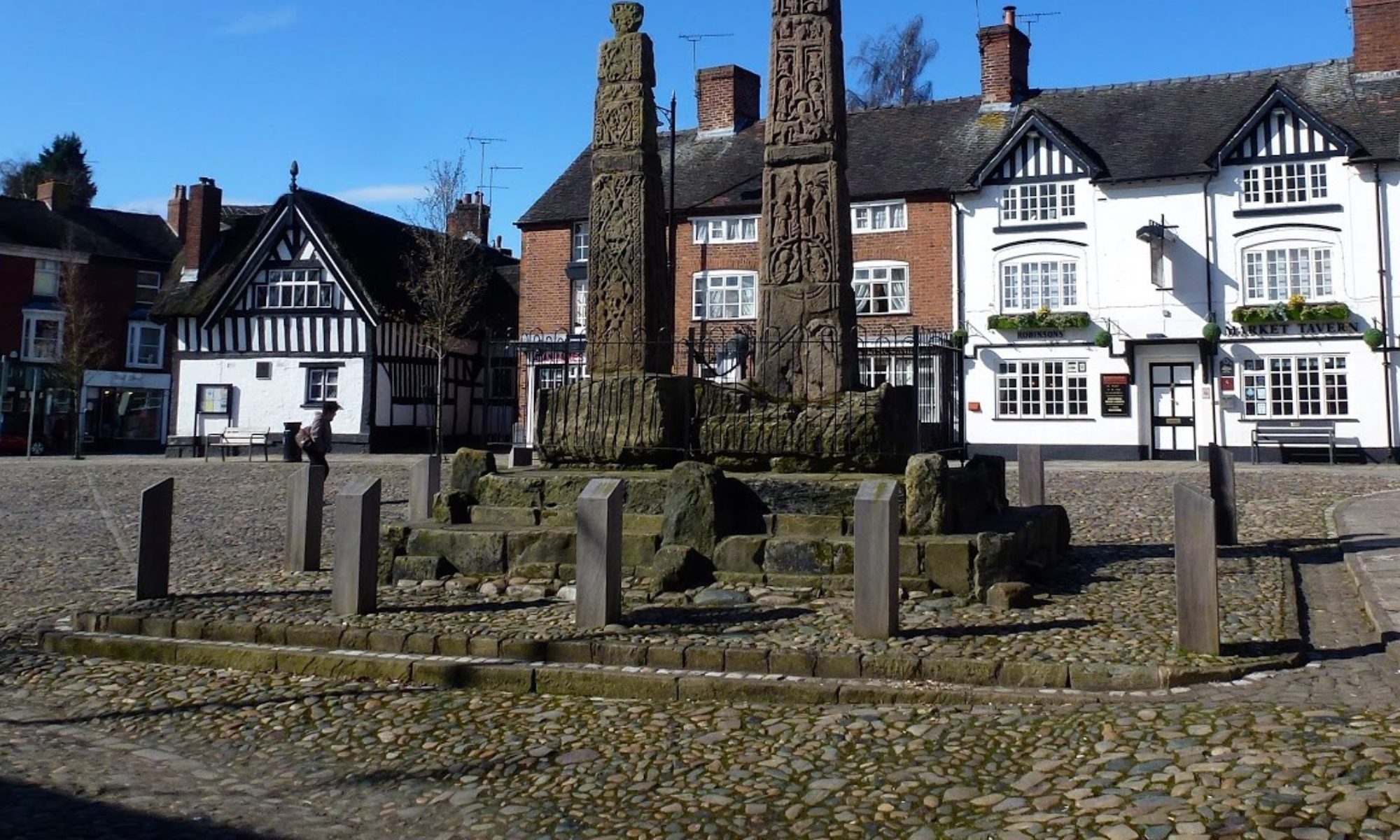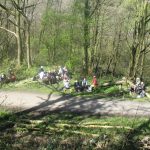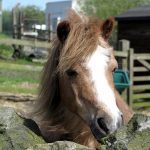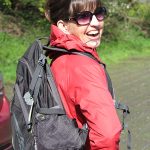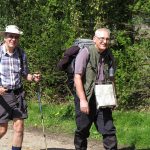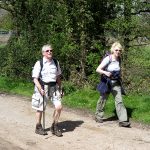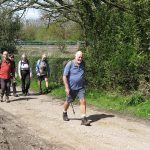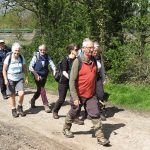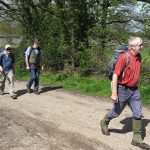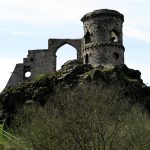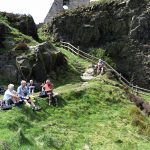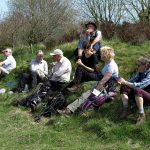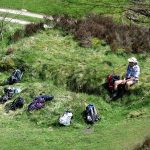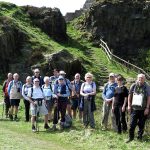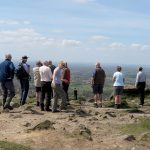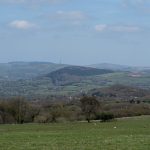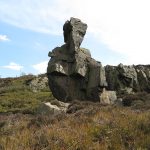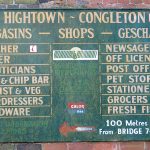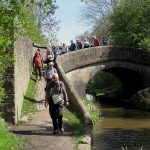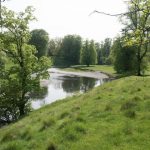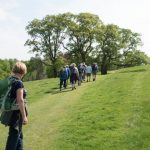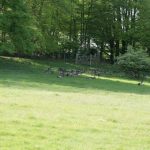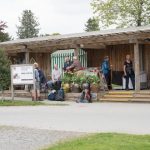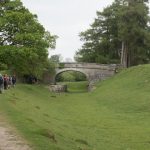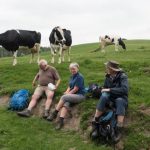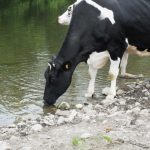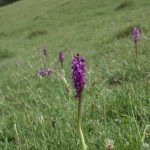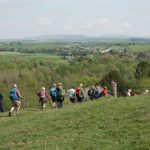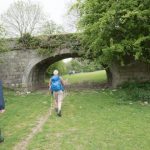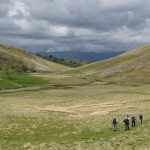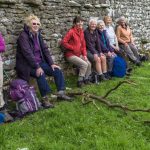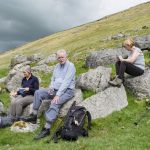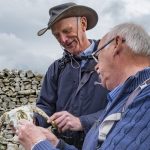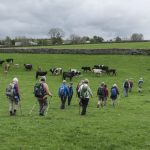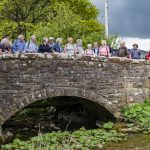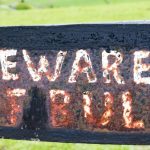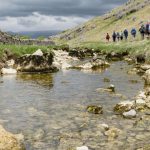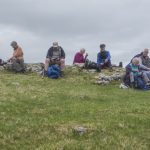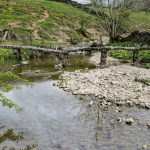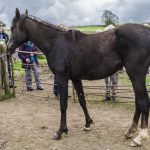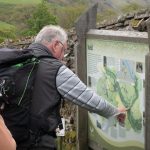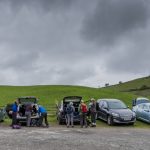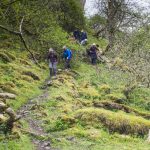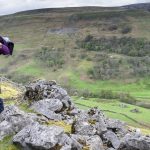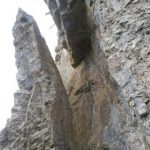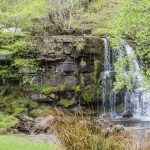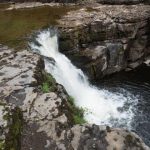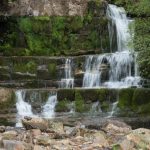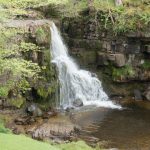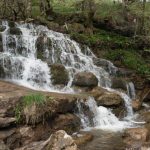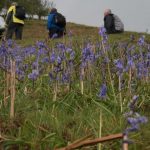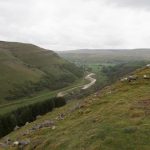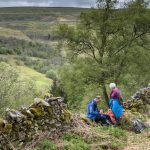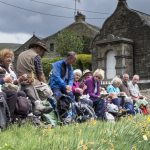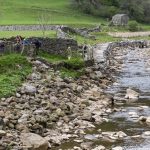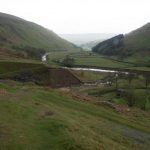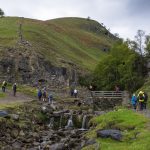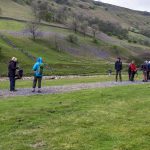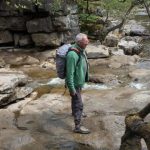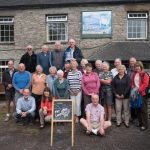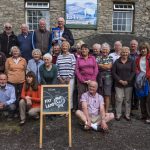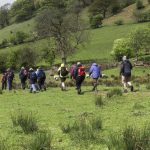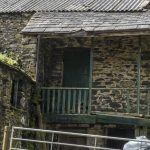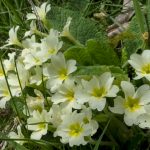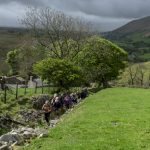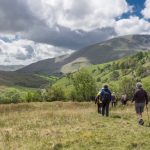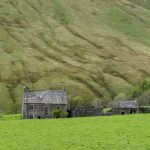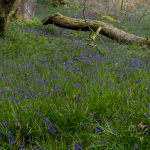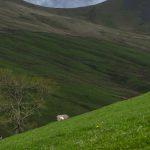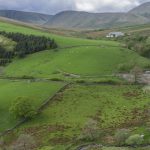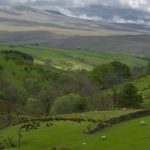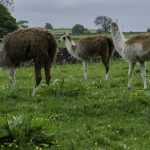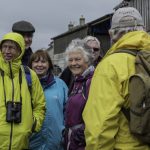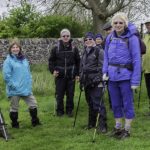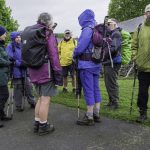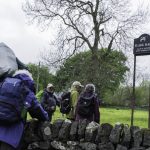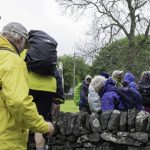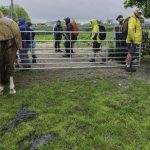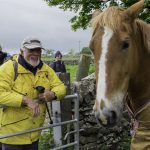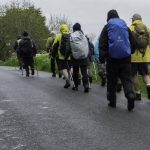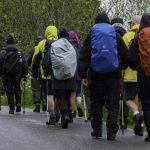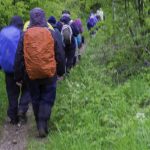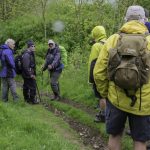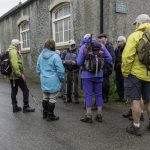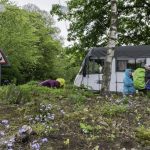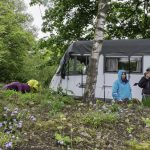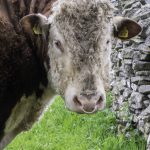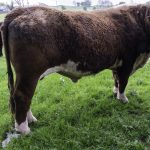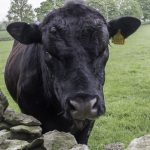4 May Walk Leader: Paul Hebden Biddulph to Mow Cop
Length of walk: 12 miles Distance to Start of Walk: 12 miles Number walking: 16
We were a bit lost at Biddulph Country Park because, with Ralph missing, we didn’t know who to wait for. We set off in the sunshine having been promised that the walk included only one hill – climbing from the Macclesfield canal to Mow Cop. What nonsense! Have you seen the number of steps you have to climb to reach the Biddulph Valley Way off the A527? We followed the disused track of the Biddulph Valley Railway that was inaugurated to bring coal from the Staffordshire coalfields to Congleton until we reached the Macclesfield Canal. We had to climb again to reach the towpath on this stretch of the walk.
The Macclesfield Canal was one of the last narrow canals to be built, indeed, during the planning process someone suggested that it be a railway. Although the Liverpool and Manchester railway opened in 1830 powered entirely by steam locomotives, railways technology was obviously seen as a future possibility in the 1820s. The route of the canal was surveyed by Thomas Telford and the completed canal was opened in November 1831.
The canal is noted for its fine stone bridges – particularly the six change or snake bridges where the towpath changes sides of the canal. These bridges were designed to allow the horse to move over without having to untie it from the boat.
Tom was trundling along the towpath at the back of the group when Lesley called on him to perform a heroic deed. A fish was flapping its last breaths in an overspill from the canal but Tom leapt in, picked it up and restored it to the brown water of the canal. He then washed the fish slime from his hands in the canal and wondered what other contaminants he had acquired. This heroism is what makes the NHS a world-beating service. Lesley herself deserves a mention; in a massive break from tradition, she was carrying a rucksack on her own back.
Since Mow Cop “castle” was visible long before we left the canal at Ackers Crossing, we had a good idea of what we had to do to reach our designated lunch stop on the other side of the folly. The biggest impediment to reaching the top was the frequent mud we encountered but the warm weather had dried it out a little.
Near the top we passed the pillar of rock known as “The Old Man of Mow”, a remnant of quarrying which may have been spared because it is on the site of a cairn that marked in the 16th century the boundary of two estates.
We scattered in the field below the “castle” on the Staffordshire side and took a well-earned lunch, having completed most of the planned walk. We were blissfully unaware that our picnic was just above the field where a small aeroplane had crashed in October 1998 killing the two occupants.
The most famous feature of Mow Cop is the folly built in 1754 as a summerhouse and picnic site for the Wilbraham family at Rode Hall. Perhaps influenced by the picnic history, the Primitive Methodists originated there at a “Camp Meeting” in 1807. The main business in Mow Cop however was quarrying and coal mining. The mines are on the Staffordshire side but the miners also wanted to send their product to the market in Cheshire so they dug a tunnel under the village and then laid a railway down to the Macclesfield Canal at Kent Green. The tunnel is on private land and has been sealed for safety but a video about it is available at http://youtu.be/uXa8dsPCOhM
Further information about mining in the area is available at http://www.mowcop.info/htm/industry/coal.htm but the most surprising thing about our visit was that nobody in the group could point exactly to Sandbach from the summit. Although the visibility was good and we used a compass, Sandbach has no structure sufficiently distinct to act as a reference point.
For our post-lunch enjoyment, we strolled along to Cheshire’s Close, down to the Biddulph Valley Way and back to the car park.
Fat Lamb Holiday Walks May 2016
Tuesday
All those intending to join the first walk of the holiday were instructed to meet in the car park of Levens Hall and a combination of good weather and a clear motorway helped achieve this aim.
Levens Hall has a deer park which we entered after hitting the café and toilets. After glimpsing some of the deer we went in search of the remains of the Lancaster Canal. This was originally intended to run from Kendal to Westhoughton near Wigan but it was never completed. The sections that were built suffered from leakage through limestone fissures and only a few isolated lengths of water-filled canal remain.
The first sight that indicated a canal had ever been there was a bridge sitting in an otherwise flat field full of sheep. It appeared that the towpath embankment had been bulldozed into the channel once the water had been let out. Further on we saw a damp section where the native flora had leapt in after dewatering.
We took lunch by the River Kent where fish occasionally popped up to see what scraps we might share. This prompted the cows from the field behind us to wander over to drink from the river and threaten us with their slobber.
The bridge to the next section of the walk had been closed but was now open, but it proved to be a very flexible structure as we crossed.
Since Sizergh Castle is handily placed as a toilet stop with ice cream and optional tours of the house or garden, we called in. After touring the gardens, I felt better about the weeds in my garden. The car park outside the café contained a section filled with a collection of Morgan cars which turned a few heads. There were also more practical comments about the vibration of the old-fashioned construction, the repair bills and the difficulty of getting out of the low down seats.
After Sizergh the walk took us back into the deer park on the other side of the River Kent and back to Levens Hall for the next stage of the journey to the Fat Lamb.
Wednesday
On the way to the start of the walk we called in at Kirkby Stephen to collect stuff for lunch.
Ralph was so keen to collect a pie that he locked Ann in the car so that she wouldn’t recommend a healthy alternative. Not surprisingly, Ann moved during her confinement triggering the alarm. It may have been this noise that persuaded Lesley to move her car from the space she had selected and move to a Disabled space. While Lesley was absent, Tom realised her error so he affected a limp and an entire medical history to explain it. Fortunately, the forces of law and order were unaware of the infraction and we left town unchallenged. We also failed to see the parakeets that allegedly inhabit the area.
Whygill Farm, site of the last recorded outbreak of foot and mouth disease in 2001, was the starting point for the walk. While on the way to the farm, our convoy acquired a man in a van who occupied one of the scarce parking places for ages while using his phone. Eventually the pressure told and he moved off so that we could close up.
We stopped for a drink by Grange Hall a freshly born lamb was tottering around its mother. The birth was so recent that the birds had not eaten the afterbirth lying in the grass. Very messy! At the other end of the life cycle, we came across the skull of a sheep, prompting Tom to demonstrate his knowledge of anatomy. It is to be hoped that the sheep in Haslington have someone just as competent to look after their health after Tom’s retirement.
After passing the tiny hamlet of Little Asby we walked over the limestone pavement of Little Asby Scar and were entertained by two RAF Typhoon fighters demonstrating how the defence budget is spent.
We took our lunch in a spectacular location on the edge of a cliff overlooking Potts Beck. Bill, who was leading, pointed to the path at the bottom of the valley which formed the next section of the walk but kindly allowed us to take the gentle slope rather than tumble down the steep direct route.
On that slope we met a woman with a baying pack of 5 fierce highland terriers. Since we have experience of dog attack, poles were deployed and the dogs were kept at bay.
We walked back along Potts Beck but down in the valley we missed seeing the Willycock Stones on Crosby Garrett Fell. One suggestion of the reason for naming them is they were a fertility symbol; another is that the farmer who informed the Ordnance Survey had a highly developed sense of humour.
We paused on our way back to examine the clapper bridge at Waterhouses. We could look but not touch this well-preserved example of a rare monument under the protection of Historic England. There are only about 40 in the country and this one has seven stones taking it over the beck.
The weather was unsettled and the waterproofs went on and off several times but it ended in warm sunshine.
At dinner a discussion centred on the BBC children’s programme “in the Night Garden” but fortunately it didn’t feature in the quiz afterwards. The winners of the excellent quiz were Keith & Jenny, Paul and Kevin. Ralph’s team was, of course, robbed but the prize, a bag of Chocolate Orange segments, was distributed to the needy among the hotel guests and staff over the next two days. Ian was question master and his wife Julie supplied the questions and the prize.
Thursday
The walk started from the campsite car park at Keld which sits at the head of Swaledale. Ralph described the walk as “up, down along and up” omitting to mention that the first “up” would take all morning. Who can resist the delights of a walk that starts in a narrow defile and opens out to views of a broad sunlit valley. We deviated from the path to visit several waterfalls down below. The hillside we walked along was scattered with drifts of primrose and bluebells prompting the resident photographers to snap away. As we walked down into Muker for lunch a Chinook helicopter flew low over the village and, as we set off on the return leg, two WW 2 vintage planes (possibly Mustangs) circled above.
The walk took us back up the same valley on the other side so we saw more waterfalls and ruins of the lead mining that employed thousands before the industry declined. A Hawk training jet followed us up the valley to continue the impromptu air show.
We experienced scattered showers on the way back but not enough to seriously wet clothing so Ernie felt he ought to demonstrate what being wet looked like. After he sat in the waterfall, Kath who was taking his picture, failed to record him in the water. Her caring side must have prevailed over hunger for a good picture.
We had the traditional concert after dinner with Chris on keyboard, Keith on guitar and Paul on mandolin; everybody else sang. Ralph performed a solo but, despite his encouragement, Les couldn’t remember the words to Mefanwy. He promised to perform it next time.
Friday
The last walk started on the way back to Sedbergh just after entering the Yorkshire Dales National Park. This was essentially a six mile tour round Wandale Hill and we all very pleased that we didn’t have to climb to the top of it. The route was dominated by even taller hills and the magic ingredient that had been largely absent from the other walks on this holiday: mud.
We turned back by a remote farm that seemed derelict but may be under a refurbishment project; a man came by with two small children in a pushchair. The farm boasted a spinning gallery, which is a feature of Lakes farm architecture. It provides a place to sit and spin the wool on a summer evening. The farm also contained a trailed loaded with dead sheep which was not quite so picturesque.
After frequent stops to put clothes on and take them off we finished the walk in sunshine ready for the trip down the motorway.
Summary
This was another splendid trip for the long walking group. The Fat Lamb was an excellent base for our walks and the staff were very helpful with excellent food to sustain our exertions. The walks provided an interesting variety of scenery without being too taxing. The weather was variable too but not too windy, too wet or too hot.
The people who made this holiday so enjoyable deserve the grateful thanks of all who took part. Thanks are due to Ralph and Ann, Bill and Ruth, Ian and Julie, musicians Chris, Keith and Paul. When I try to think who I might have left out, it is difficult not to think that everybody on the holiday played a part in making it enjoyable but I have to mention the organisers without whom we would have missed a wonderful experience.
25 May Walk Leader: Bill & Ruth Crichton Sheldon, Monyash Flagg & Taddington
Length of walk: 9.75 miles Number walking: 14
Spurred on by the totally unwarranted and shameful innuendo made in the review for the 4th May, the first person ready on this walk was Ralph (though it has to be said that he was the only one not to undertake the half mile walk to the toilet). In the usual true spirit of adventure, we set off up a 33% muddy incline without complaint – until reaching the attractive village of Sheldon. This has many claims to fame but the most significant is the Cock and Pullet – built to blend perfectly into the surrounding buildings – in 1995. This worthy establishment succeeded the closure of the Devonshire Arms 25 years previously. One of the party was overwhelmed with nostalgia at this point, as he recalled the frequent visits here – mostly with his Dad and his friend, Les – to be served with wonderful ale, brought up fresh from the cellar in a creamy white jug; then poured into a proper tankard by one of the sweet old sisters who ran the pub, until their demise led to the afore-mentioned closure.
The two ladies would have remembered serving the lead miners who formed the backbone of the village community – many of whom would have worked at our next port of call – the Magpie Mine. Here, the surface remains are the best example in Britain of a 19th century lead mine – with impressive mine buildings and winding gear. It was good to see that renovation and maintenance is ongoing, and I am sure the group will visit again in the future.
The highlights of the remaining part of the walk (as well as the beautiful persistent rain!) were visits to three other charming village communities – each with their own unique character and Bill was able to give an informative appraisal of each (We’ll turn him into a surrogate Derbyshire man yet!). Lunch was taken on the village green in Monyash – a pleasant experience that the rain could not diminish.
The villages of Flagg and Taddington were also visited, before a final descent to the White Lodge Car Park. Altogether, a smashing walk – the rain did its best, but could not diminish the spirit that epitomises the group.
It was very good to see John and Doreen back amongst us – after their travels helping Mike and Linda and Family repatriate from their traumas in Australia. Hopefully it will not be long before Linda is out again and – in the fullness of time – Mike also – even if we have to get him electric crutches!
